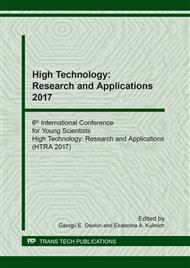[1]
Schur D.V., Dubovoy A.G., Lysenko E.A., GolovchenkoТ.N., ZaginaichenkoS.Yu., Savenko A.F., Adeev V.M., Kaverina S.N., Synthesis of nanotubes in the liquid phase, Proceedings of VIII International Conference Hydrogen Material Science and Chemistry of Metal Hydrides,, Ukraine, (2003).
DOI: 10.1007/1-4020-2669-2_14
Google Scholar
[2]
Zolotarenko A.D., Gabdullin M.T., Shchur D.V., ZaginaichenkoS.Yu., Dubovoi A.G., Pomytkin A.P., A. Magrez, M. Baibarac, Features of the formation processes of nanostructures in the liquid phase, Collected papers of the international conference «SDFFFO-8», Almaty, 2013, pp.210-212.
Google Scholar
[3]
Gabdullin M.T., Ramazanov T.S., AbdullinKh.A., Batryshev D.G., Ismailov D.V., Orazbayev S.A., White book on nanotechnologies, The synthesis of nanopowders by the method of electric arc deflocculation in the liquid phase, under the editorship of Mansurov Z.A., Gabdullin M.T., Almaty, 2014, pp.87-88.
Google Scholar
[4]
Keypour et al., An improved method for the purification of fullerene from fullerene soot with activated carbon, celite, and silica gel stationary phases, Journal Of Nanostructure in Chemistry. 3 (2013) 45-48.
DOI: 10.1186/2193-8865-3-45
Google Scholar
[5]
Loutfy R.O. and Wexler E.M., Investigation of hydrogen storage in fullerene hydrides, Materials and Electrochemical Research (MER) Corporation, Arizona, (2001).
Google Scholar


